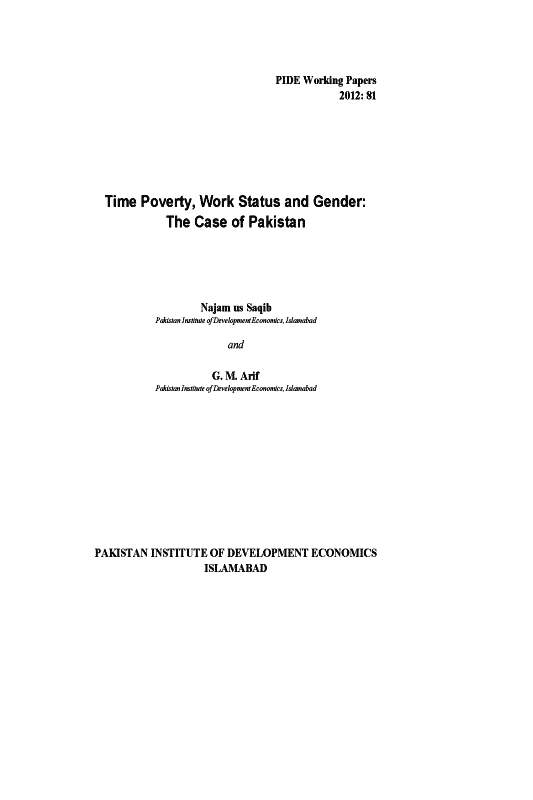
Pakistan Institute of Development Economics
- Home
Our Portals
MenuMenuMenuMenuMenuMenuMenu - ResearchMenuMenuMenuMenuMenuMenuMenu
- Discourse
- The PDR
- Our Researchers
- Academics
- Degree Verification
- Thesis Portal
- Our Portals
Time Poverty, Work Status and Gender: The Case of Pakistan (PIDE Working Papers 2012: 81)
Time is an important economic resource that can be spent in a variety of ways. Diverse demands on a person’s time may reach a point where the individual may be categorized as time poor. Time poverty may vary across gender, occupational groups, industries, regions, and income levels. The present study focuses on measurement of time poverty and its incidence among these categories using Time Use Survey (TUS) 2007, the first nationwide time use survey for Pakistan. The results of this study provide some important insights into the phenomenon of time poverty in Pakistan and lead to some interesting conclusions. In the entire TUS sample, the incidence of time poverty is 14 percent. Women are found to be more time poor than men whether they are employed or not. A closer look at time use statistics reveals the reason behind this occurrence. There are certain women-specific activities that they have to perform irrespective of their employment status. This additional time burden plays a key role in making them more time poor. Working women are far more time poor as compared to not working women. Thus, while accepting a job, women have to deal with a major tradeoff between time poverty and monetary poverty. People in certain professions and industries are more time poor as compared to people in other professions and industries. These professions and industries generally require extended hours from the workers, while offering low wage rates. This entails a situation of double jeopardy for the workers who tend to be monetary and time poor at the same time. The close association of time poverty with low income found in this study corroborates this conclusion. In the light of these findings, several policy areas emerge where we need to focus. First thing that needs to be done is to generate awareness about a fair distribution of responsibilities between men and women. Government can also play its part in reducing time poverty by enforce minimum wage laws and mandatory ceiling on work hours in the industries which have high concentration of time poverty. Eradication of monetary poverty can also go a long way in this respect by eliminating the need to work long hours at the lowest wage rate just to survive. Improving education also has significant potential in this regard, as high education is found to be associated with low time poverty.



